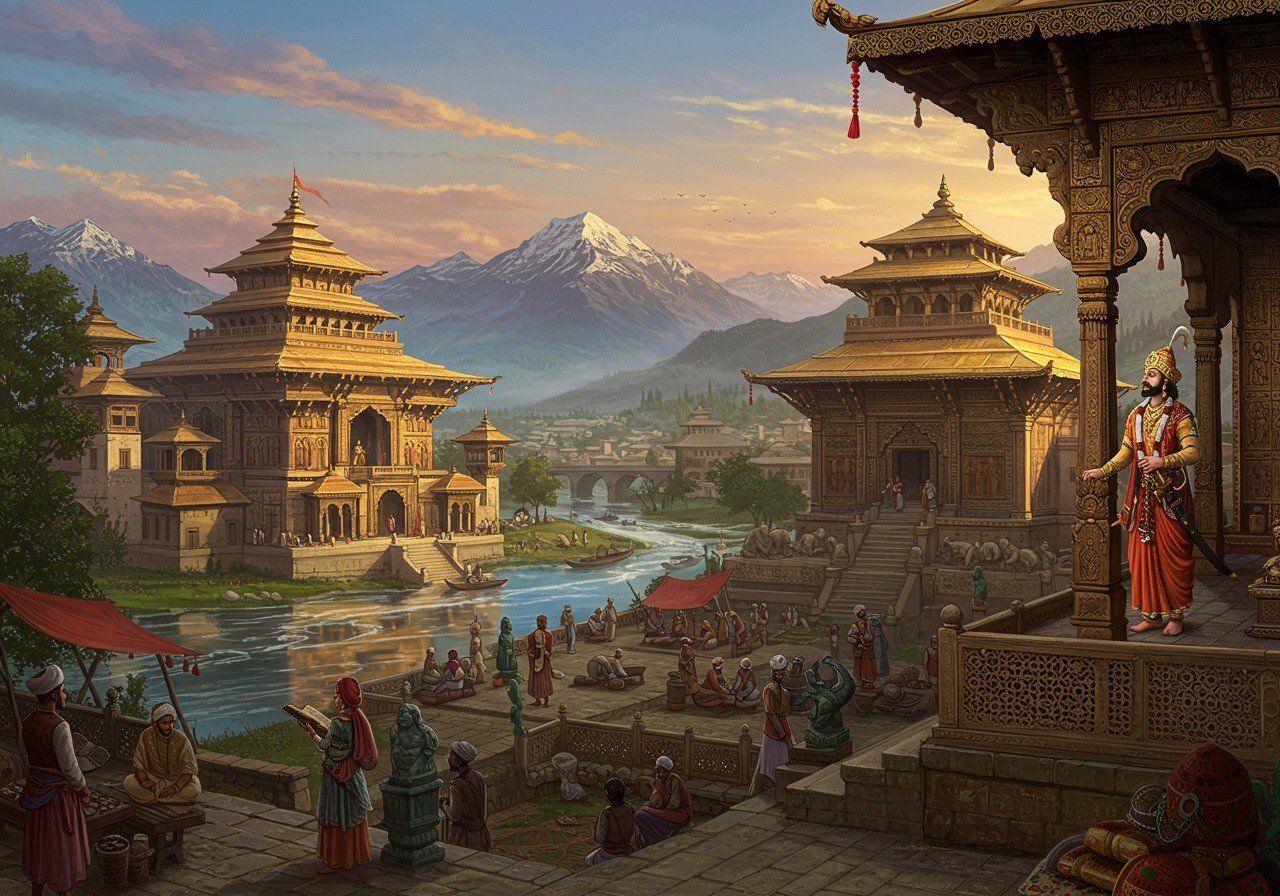
The Karkota dynasty, a prominent power in the Kashmir region, reigned from approximately 625 to 855 CE. This era witnessed remarkable political expansion, economic prosperity, and significant cultural advancements. Established by Durlabhavardhana, the dynasty’s history is meticulously chronicled in Kalhana’s 12th-century masterpiece, Rajatarangini, a work drawing upon a wealth of historical sources. Under the Karkotas, Kashmir flourished as a hub of learning and culture, with texts like the Nilamata Purana offering valuable insights into the daily lives, festivals, and rituals of the time.
Origins and Rise of the Karkota Dynasty
Durlabhavardhana laid the foundation of the Karkota Empire around 625 CE. Kashmir’s strategic location played a pivotal role in its growth, facilitating trade and military activities. The pre-Karkota period saw Kashmir as a melting pot of diverse cultures and religions. The Karkotas skillfully navigated these complexities, employing effective administrative and military strategies to consolidate their power and expand their territories.
- Durlabhavardhana’s Foundation: Durlabhavardhana’s establishment of the dynasty marked a turning point in Kashmir’s history, setting the stage for centuries of Karkota influence.
- Strategic Significance of Kashmir: Kashmir’s geographical position at the crossroads of major trade routes contributed significantly to its economic and political importance.
- Early Challenges and Consolidation: The early Karkota rulers faced the challenge of consolidating power amidst a diverse cultural and political landscape, requiring strategic alliances and military campaigns.
Prominent Karkota Rulers and Their Contributions
Lalitaditya Muktapida stands out as one of the most illustrious Karkota rulers. His reign, spanning from 724 to 760 CE, was marked by extensive military conquests and shrewd diplomatic relations with neighboring kingdoms. Lalitaditya’s patronage led to the construction of magnificent structures, including the iconic Martand Sun Temple. Other notable rulers include:
- Durlabhaka: Known for his administrative reforms and contributions to cultural development, Durlabhaka strengthened the foundations of the Karkota state.
- Jayapida: Focusing on military expansion and economic policies, Jayapida extended the empire’s reach and fostered economic growth.
- Queen Didda: A powerful and influential figure, Queen Didda played a significant role in shaping the political landscape of later Karkota rule.
Cultural and Religious Flourishing Under the Karkotas
The Karkota period witnessed a remarkable cultural renaissance, marked by advancements in art, literature, and architecture. Both Hinduism and Buddhism thrived under their patronage. The Karkotas generously supported temples, monasteries, and educational institutions, fostering intellectual and artistic growth.
- Patronage of Arts and Education: Karkota rulers actively supported the arts, literature, and education, leading to a flourishing of intellectual and creative pursuits.
- Religious Harmony and Diversity: The Karkota era saw a period of relative religious harmony, with both Hinduism and Buddhism receiving royal patronage.
- Cultural Exchange and Enrichment: Cultural exchange with neighboring regions contributed to a vibrant and diverse cultural landscape in Kashmir.
Architectural Marvels of the Karkota Era
The Karkota dynasty left behind a legacy of impressive architectural achievements, showcasing unique styles and innovative techniques. The Martand Sun Temple stands as a prime example of their architectural prowess. Other notable structures include Parihaspora and the Shankaracharya Temple.
- Martand Sun Temple: A masterpiece of Kashmiri architecture, the Martand Sun Temple reflects the grandeur and artistic skill of the Karkota period. Learn more about the spiritual heart of Kashmir.
- Parihaspora: This ancient city, built by Lalitaditya Muktapida, showcases the Karkotas’ urban planning and architectural skills. Explore the architecture, history, and spirituality of the Shankaracharya Temple.
- Shankaracharya Temple: Perched atop a hill, the Shankaracharya Temple offers breathtaking views and represents the Karkotas’ reverence for religious sites.
Decline and Enduring Legacy
The 9th century marked the beginning of the Karkota dynasty’s decline. A confluence of factors contributed to their downfall, including invasions from neighboring kingdoms, internal political instability, and economic challenges. Despite their eventual decline, the Karkota legacy endures, particularly in their architectural marvels and cultural contributions, which continue to inspire and intrigue. Ongoing research and archaeological discoveries further illuminate the rich history of this significant dynasty.
Poojn.in and the Karkota Legacy: At Poojn.in, we appreciate the rich cultural heritage of Kashmir. We offer a wide selection of puja items, including brass murtis and traditional clothing, allowing you to connect with the spiritual traditions of the region. Explore our collection and bring a piece of history into your home.


